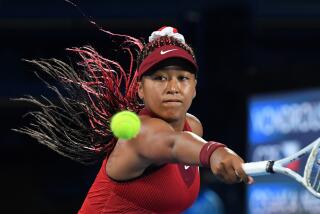Agassi May Be No. 1, but He Doesn’t Look It
- Share via
Time for eating crow, and for reviewing the always controversial rankings.
Looking to move up from No. 2 in the ranking, Andre Agassi said during the early stages of the just-completed Australian Open: “If I don’t win this tournament, I don’t want to be ranked No. 1.”
Oops. That was said after then-No. 1 Pete Sampras was ousted in the third round and it looked as if Agassi would encounter little resistance on his way to reclaiming the title. It was also well before Agassi got his racket handed to him by Michael Chang in the semifinals.
After losing to Chang, Agassi revised his earlier statement to note that the ranking is also a reflection of an entire year’s work, not the measure of performance at a single tournament--a self-serving reassessment if ever there was one.
Agassi gained the No. 1 ranking, but his play and attitude during the Australian Open have damaged a reputation he had carefully reconstructed. For the first time in the two years since his return after wrist surgery, Agassi is showing signs of his underachieving former self.
The unconvincing chest injury that kept Agassi out of the Davis Cup final was presumably the problem that sent him to Australia out of shape and overweight. His tennis was mercurial, to say the least. He looked shabby and needed five sets to defeat a qualifier, then showed pluck in coming back from two sets down to beat Jim Courier.
It was the Chang match that did the damage. Agassi didn’t so much lose to Chang as capitulate. Where he had shown courage and skill in coming back against Courier, Agassi showed only lethargy and lack of interest against Chang. He didn’t move to the ball, and when he did connect, his shots were wild and lacking conviction.
Worse, it didn’t appear that he cared.
Still, thanks to the convolutions of the ATP computer, Agassi comes away with the No. 1 ranking. This week’s top five: No. 1 Agassi, No. 2 Thomas Muster, No. 3 Sampras, No. 4 Boris Becker, No. 5 Chang.
Scary thought: Had Agassi lost to Courier, clay-court specialist Muster would be No. 1.
Muster accumulated most of his points by winning 12 tournaments in 1995, all on clay, including the French Open. Muster does not play at Wimbledon or in other grass tournaments, and doesn’t have a big indoor schedule. He scoffs at the suggestion that to be judged a truly great player, he must play on all surfaces.
Not surprisingly, Muster argues that points are points, and no matter how they are earned, they should be honored.
“Whatever the computer prints out, that’s the No. 1,” he said. “There is nobody [who is] No. 1 who doesn’t deserve it.”
It was left to the outspoken Courier to give voice to what other players would never dare utter outside the locker room.
“Thomas has had a sensational year in the past 52 weeks, and if he does become No. 1, he’s earned every bit of it, as far as the computer goes,” Courier said. “As far as the players feel, until he proves that he can win a Grand Slam event on another surface other than clay, then he’s not No. 1 in my mind or most of the other top players.”
And Agassi is?
*
The women have no such controversy, for once. Monica Seles continues to amaze after winning her fourth Australian title and still has never lost at Flinders Park.
She won without the challenge of Steffi Graf, co-ranked No. 1, but also having overcome a mysterious virus, a sprained ankle, ongoing tendinitis in her knee, a strained groin muscle, and--on the eve of her semifinal against Chanda Rubin--a shoulder injury.
There is one more tournament left in Seles’ ambitious experiment of playing four weeks in a row. Given her precarious physical condition since she came back last summer, it’s still puzzling that Seles would choose to push her body.
Still, she seemed comfortable in Melbourne. Seles said her Australian title in 1992 marked the first time she felt comfortable with the mantle of No. 1. Months later she was stabbed in the back in Germany and was out of the game for more than two years.
How sad, then, that after winning again, Seles was driven out of the interview room in tears. Persistent questions about erroneous reports that she will soon be returning to Germany to play caused Seles to burst into tears. She lowered her head and, still sobbing, asked photographers not to take pictures. None complied.
Seles fled the stadium, leaving behind her winner’s trophy.
In the absence of Graf--herself a courageous champion--there can be no debate about the accuracy of Seles’ No. 1 ranking.
*
After she lost in the second round, defending women’s champion Mary Pierce was dumped by her coach, Nick Bollettieri.
Bollettieri was publicly critical of Pierce’s commitment to her sport, but Pierce got the last word, saying, “Maybe Nick’s version of commitment is waking up at 5, running 10 miles a day, staying on the court 10 hours, eating celery sticks all day and going to bed at 8, but that’s not a life for anybody.”
*
After losing to a qualifier in singles, Stefan Edberg finished his last Australian Open in style, teaming with Petr Korda to win the men’s doubles.
More to Read
Go beyond the scoreboard
Get the latest on L.A.'s teams in the daily Sports Report newsletter.
You may occasionally receive promotional content from the Los Angeles Times.











